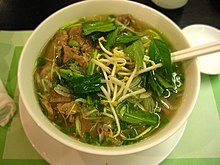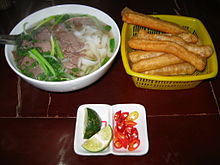Pho
 Pho with sliced rare beef and well-done beef brisket | |
| Type | Noodle soup |
|---|---|
| Course | Main course |
| Place of origin | Vietnam |
| Region or state | Nam Định Province |
| Invented | 1900–1907[1] |
| Serving temperature | Warm |
| Main ingredients | Rice noodles and beef or chicken |
Phở or pho[2] (UK: /fɜː/, US: /fʌ, foʊ/, Canada: /fɑː/;[3] Vietnamese: [fəː˧˩˧] (![]() listen)) is a Vietnamese soup dish consisting of broth, rice noodles (bánh phở), herbs, and meat (usually beef) (phở bò), sometimes chicken (phở gà).[4][5] Pho is a popular food in Vietnam[6] where it is served in households, street stalls and restaurants countrywide. Pho is considered Vietnam's national dish.[7]
listen)) is a Vietnamese soup dish consisting of broth, rice noodles (bánh phở), herbs, and meat (usually beef) (phở bò), sometimes chicken (phở gà).[4][5] Pho is a popular food in Vietnam[6] where it is served in households, street stalls and restaurants countrywide. Pho is considered Vietnam's national dish.[7]
Pho originated in the early 20th century in northern Vietnam, and was popularized throughout the world by refugees after the Vietnam War. Because Pho's origins are poorly documented,[8][9] there is disagreement over the cultural influences that led to its development in Vietnam, as well as the etymology of the name.[10] The Hanoi (northern) and Saigon (southern) styles of pho differ by noodle width, sweetness of broth, and choice of herbs.
History[]
Pho likely evolved from similar noodle dishes. For example, villagers in Vân Cù say they ate pho long before the French colonial period.[11] The modern form emerged between 1900 and 1907 in northern Vietnam,[1][8] southeast of Hanoi in Nam Định Province, then a substantial textile market. The traditional home of pho is reputed to be the villages of Vân Cù and Dao Cù (or Giao Cù) in Đông Xuân commune, Nam Trực District, Nam Định Province.[11][12]
Cultural historian and researcher Trịnh Quang Dũng believes that the popularization and origins of modern pho stemmed from the intersection of several historical and cultural factors in the early 20th century.[13] These include improved availability of beef due to French demand, which in turn produced beef bones that were purchased by Chinese workers to make into a dish similar to pho called ngưu nhục phấn.[13][14] The demand for this dish was initially the greatest with workers from the provinces of Yunnan and Guangdong, who had an affinity for the dish due to its similarities to that of their homeland, which eventually popularized and familiarized this dish with the general population.[14]
Pho was originally sold at dawn and dusk by itinerant street vendors, who shouldered mobile kitchens on carrying poles (gánh phở).[15] From the pole hung two wooden cabinets, one housing a cauldron over a wood fire, the other storing noodles, spices, cookware, and space to prepare a bowl of pho. The heavy gánh was always shouldered by men.[16] They kept their heads warm with distinctive, disheveled felt hats called mũ phở.[17]
Hanoi's first two fixed pho stands were a Vietnamese-owned Cát Tường on Cầu Gỗ Street and a Chinese-owned stand in front of Bờ Hồ tram stop. They were joined in 1918 by two more on Quạt Row and Đồng Row.[18] Around 1925, a Vân Cù villager named Vạn opened the first "Nam Định style" pho stand in Hanoi.[19] Gánh phở declined in number around 1936–1946 in favor of stationary eateries.[17]
Development[]
In the late 1920s, various vendors experimented with húng lìu, sesame oil, tofu, and even Lethocerus indicus extract (cà cuống). This "phở cải lương" failed to enter the mainstream.[18][20]
Phở tái, served with rare beef, had been introduced by 1930. Chicken pho appeared in 1939, possibly because beef was not sold at the markets on Mondays and Fridays at the time.[18]

With the partition of Vietnam in 1954, over a million people fled North Vietnam for South Vietnam. Pho, previously unpopular in the South, suddenly became popular.[12] No longer confined to northern culinary traditions, variations in meat and broth appeared, and additional garnishes, such as lime, mung bean sprouts (giá đỗ), culantro (ngò gai), cinnamon basil (húng quế), Hoisin sauce (tương đen), and hot Sriracha sauce (tương ớt) became standard fare.[8][12][18][21] Phở tái also began to rival fully cooked phở chín in popularity. Migrants from the North similarly popularized bánh mì sandwiches.[22]
Meanwhile, in North Vietnam, private pho restaurants were nationalized (mậu dịch quốc doanh)[23] and began serving pho noodles made from old rice. Street vendors were forced to use noodles made of imported potato flour.[24][25] Officially banned as capitalism, these vendors prized portability, carrying their wares on gánh and setting out plastic stools for customers.[26]

During the so-called "subsidy period" following the Vietnam War, state-owned pho eateries served a meatless variety of the dish known as "pilotless pho" (phở không người lái),[27] in reference to the U.S. Air Force's unmanned reconnaissance drones. The broth consisted of boiled water with MSG added for taste, as there were often shortages on various foodstuffs like meat and rice during that period.[28] Bread or cold rice was often served as a side dish, leading to the present-day practice of dipping quẩy in pho.[29]
Pho eateries were privatized as part of Đổi Mới. Many street vendors must still maintain a light footprint to evade police enforcing the street tidiness rules that replaced the ban on private ownership.[26]
Globalization[]

In the aftermath of the Vietnam War, Vietnamese refugees brought pho to many countries. Restaurants specializing in pho appeared in numerous Asian enclaves and Little Saigons, such as in Paris and in major cities in the United States, Canada and Australia.[30][31] In 1980, the first of hundreds of pho restaurants opened in the Little Saigon in Orange County, California.[32]
In the United States, pho began to enter the mainstream during the 1990s, as relations between the U.S. and Vietnam improved.[31] At that time Vietnamese restaurants began opening quickly in Texas and California, spreading rapidly along the Gulf and West Coasts, as well as the East Coast and the rest of the country. During the 2000s, pho restaurants in the United States generated US$500 million in annual revenue, according to an unofficial estimate.[33] Pho can now be found in cafeterias at many college and corporate campuses, especially on the West Coast.[31]
The word "pho" was added to the Shorter Oxford English Dictionary in 2007.[34] Pho is listed at number 28 on "World's 50 most delicious foods" compiled by CNN Go in 2011.[35] The Vietnamese Embassy in Mexico celebrated Pho Day on April 3, 2016, with Osaka Prefecture holding a similar commemoration the following day.[36] Pho has been adopted by other Southeast Asian cuisines, including Lao and Hmong cuisine.[5] It sometimes appears as "Phô" on menus in Australia.
Etymology and origins[]
| Pho | |
|---|---|
| Vietnamese name | |
| Vietnamese alphabet | phở |
| Chữ Nôm | WIKI |